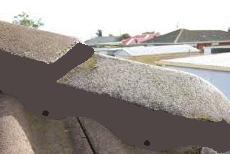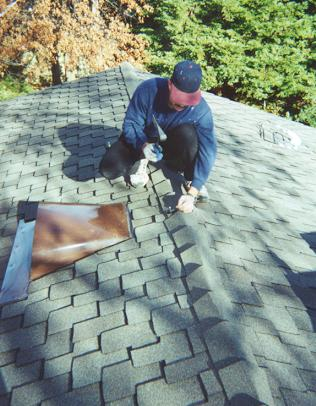What Roof is Best for my Climate?

By Quarrix.
How to find the right roofing materials suited to your climate.
If you were to take a road trip across America, you can see for yourself that we get just about every kind of weather. The U.S. is a huge country and has a variety of climates; coast to coast the weather oscillates from cold and dry to hot and humid. When it comes to choosing roofing materials, it can be hard to know what kind of materials are best suited for your environment and will best protect your home. Because the weather can differ so much throughout America, homeowners need to do their due diligence when it comes to choosing materials for their homes.
After all, carefully selecting key products with the features most suited to your climate will make a major difference in how well those products perform against the elements, how long they last and the amount of return you get back on your hard-earned investment. That means giving serious thought to how much you need to invest in your building materials to sustain the durability and longevity of your home over time.
“The answer comes from learning what you can expect of the materials or building components, deciding what you want to pay and thinking about what suits your house design or remodeling project,” advises Bill Hirsch, architect and author of “Designing Your Perfect House.” “Most of the time you can count on replacing or repairing the less expensive item sooner than the one that costs more at the outset. Unless your budget is extremely limited, I suggest you consider the life-cycle cost method of analysis.”
That's especially true when it comes to selecting the roofing materials that will offer the best performance and appearance for the price. Your choice among the many options available today — including stone coated steel, standing seam metal, wood, rubber, slate, concrete, plastic composite, clay and asphalt — will make a significant difference in your roof’s ability to withstand the weather conditions in your area of the U.S., as well as the time frame in which you’ll need to replace your roof to keep it beautiful, sound and effective.
The right materials for the right climate
If your region is prone to high winds, heavy snows, continual moisture or wildfires, for example, you’ll want a material and style that can withstand those conditions as much as possible. Consider this run-down of the different materials and their pros and cons in terms of your climate.
Cold, icy and snowy: In areas subject to heavy winter precipitation such as Michigan, Minnesota and Wisconsin, stone coated steel steps up like a champ. It’s waterproof, resistant to the freezing and thawing process and is nearly immune to fading, cracking and corrosion, specifically built to maintain structural integrity through 50 seasons or more. It offers some of the best hailstone resistance available, far surpassing the resistance offered by clay or concrete — and qualifying owners for home insurance discounts in some states. It can also withstand the highest wind speeds of all available materials, often warrantied for speeds up to 120 mph. In comparison, options such as concrete, clay or wood shakes offer little to no wind protection, while the others are usually warrantied for lower wind speeds. Though other workable cold-weather roofing options include rubber, thermoplastic, asphalt, clay, concrete or slate, stone coated steel is the lightest-weight material, weighing as little as 1.5 pounds per square foot. That’s important, since choosing a heavier material may require the installation of extra roof reinforcements to support both the weight imposed by the material itself in addition to the piles of snow that can accumulate on top.
Dry, hot and arid: Homeowners in hot desert climates found in places like Arizona, Nevada and Utah need a roof that will deflect extreme heat instead of absorbing and drawing it into the house. Stone coated steel, concrete, ceramic or clay can all be excellent choices, as they block heat and offer wind resistance and protection against fire damage. Conversely, you should avoid heat-absorbing materials such as asphalt and organic materials such as wood or rubber that can shrink and crack when sun-warmed then cooled quickly by precipitation.
Humid, hot and muggy: In places like Florida, Georgia, North Carolina and South Carolina, heat and moisture can be problematic, and saltwater can corrode roofing materials even when the buildings in question are miles away from the sea. One excellent option in such environments is stone coated steel, which is rust-resistant, waterproof and superior at deflecting high winds due to hurricanes and other storms. Other heat-reflecting options in southern regions include concrete or clay. Another element to consider is color; in general, lighter-colored roofs deflect the sun’s rays and minimize wear and tear on your air conditioner, while darker options such as black can absorb heat and transfer it into rooms below.
Moderate: If you live in a moderate climate with no great extremes such as that found in many Midwestern and Pacific Northwest states, you have a wider range of viable roofing options. That means your choice may logically be based more on overall quality, price, longevity and attractiveness than on weather hardiness. Your most important criterion may be the length and depth of your warranty; seek an agreement that covers your roof for 30 to 50 years, or better yet choose the lifetime warranty offered by certain stone coated steel products.
Prone to wildfires: If fire is a significant threat in your area, you’ll want to pay extra attention to whether the roofing material you’re considering is ranked Class A, B or C for fire resistance. Slate and concrete tend to be the most fire-resistant options, though stone coated steel can be graded Class A when the proper underlayments are used. Wood is often ranked Class C and should probably be avoided, though it can be treated with factory-applied fire retardants that improve its resistance.
Prone to earthquakes: Stone coated steel offers the best protection against earthquakes (boasting a Class 4 impact rating) because of its minimal weight and added shear strength, which optimizes its resistance against shifting under pressure. Concrete and clay are usually low in shear strength, while other roofing materials provide low-to-moderate resistance.
Narrowing your choices further
Once you've whittled down your options based on the prevailing weather in your area, you'll want to consider other criteria for choosing your best possible roofing. Some questions to ponder:
How long will you live in your home? If you’re planning to move in a year or two, you may not be so concerned about longevity. But a roofing product that offers a transferable warranty can add to the value of your home in the eyes of a potential buyer. And if you plan to settle into your home for the long term, you’ll certainly want to invest in a high-quality material that won’t need routine replacement in a decade or two just because of everyday wear and tear. Thanks to advanced engineering, stone coated steel and some other materials on the market can now last 50 years or more and are often guaranteed as such.
Is your roof construction strong enough for any material? If you’re considering a heavier material such as concrete, slate or clay, you may need to consult with a builder to find out if your roof needs reinforced framing. Conversely, lighter-weight options such as stone coated metal or other metals are unlikely to be problematic.
Is your roof sloped enough to optimize any material? If you’re dealing with one of the flatter roofs featured on 1960s-era or contemporary-style homes, for example, complete waterproofing may be more of an issue. Flat roofs are far less able to shed rainwater through gravity alone, and as such don’t function well with conventional asphalt shingles and certain other materials. Unsure of the pitch of your roof? Follow these instructions for easily taking measurements from inside your attic.
Which choices are most eco-friendly and/or recyclable? If you’re environmentally conscious, you’ll want to know how your roofing materials rank in terms of how they’re manufactured, what extra materials they require for installation (i.e., “tear-off”) and to what extent they’re recycled. The asphalt composition shingles applied to an estimated 80 percent of homes in the U.S. are petroleum-based and not eco-friendly; some are recyclable, but they often end up in landfills. In comparison, stone coated steel and standing seam metal are both considered to have a low environmental impact, since they’re built from recycled materials and can be recycled again upon replacement. Synthetics, concrete and clay are all ranked high impact, while fiber cement and wood shakes are ranked moderate.
What level of energy efficiency are you seeking? To help control your heating and cooling bills (and perhaps earn you ENERGY STAR® tax credits), check the efficiency rating of any material you’re considering.
What design choices will look best with your home style? When in doubt, consult with a designer to determine which roofing styles align best with the lines and features of your home. You may wish to spend a little more to achieve a certain look or maintain a sense of elegance and panache.
What level of maintenance can you handle? How often can you expect repairs and replacements with your material of choice? In general, the materials considered lowest maintenance are stone coated steel, composites and architectural shingles. Wood shakes are considered high maintenance, and the others range from moderate to high.
What return on investment are you seeking? Do the math to determine whether the money you plan to spend will pay off in terms of performance. For example, slate can be the most expensive at about $1,100 to $2,000/square foot, but can last more than 75 years. Stone coated steel and standing seam metal are less expensive and offer the next-highest longevity at more than 50 years, followed by plastic polymer and clay or concrete tile. Asphalt is typically the least-expensive material at $75 to $200/square foot installed, but only lasts 15 to 30 years before requiring replacement. Make sure you factor in warranties and exactly what they will cover, noting that some won’t transfer once you sell your home, some are prorated over time and others are limited to material costs.
The right ventilation for the roofing material?
Whether you’re building a new home or replacing the roof on your current home, you’ll want to strongly consider the pros and cons of the many roofing materials now on the market. One thing you won't have to weigh the benefits of is which ventilation type is best for your roof. Ridge ventilation is hands down the best choice when it comes to ventilation. Some ridge vents don't work with all types of roofs or roofing materials. The good news, is that Quarrix StormStop Ridge Vent fits almost all roofing types.
Have a question? AskARoofer.
Find your local roofing contractor in the RoofersCoffeeShop® Contractor Directory.









Comments
Leave a Reply
Have an account? Login to leave a comment!
Sign In